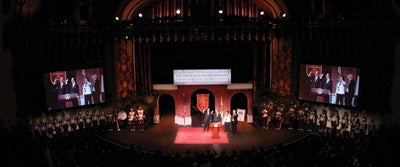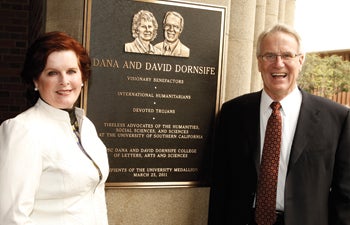On March 23, 2011, USC Board of Trustees Chair Edward P. Roski Jr., President C. L. Max Nikias and Dean Howard Gillman presided over a spectacular ceremony including a stage set representing the archetypal USC classical building. With the majestic notes of the USC Trojan Marching Band ringing loud and proud as it played the “Reign of Troy,” the heart of the university became officially known as the USC Dana and David Dornsife College of Letters, Arts and Sciences.
During the Bovard Auditorium ceremony, Nikias presented Dana and David Dornsife with the University Medallion, the highest honor given to those who have made major contributions to the university. The award has only been given once before, in 1994, to the late Walter Annenberg.
As the words — USC Dana and David Dornsife College of Letters, Arts and Sciences — fired across the stage in a dramatic lighting display, the full-capacity crowd ignited in excitement and pride.

USC celebrating the newly named USC Dana and David Dornsife College of Letters, Arts and Sciences on March 23, 2011. (Photo: Phil Channing.)
All who spoke sang the praises of Dana and David, longtime supporters of the university and international philanthropists. They have given the largest single gift in USC’s history — $200 million — to name its college of letters, arts and sciences.
“I spent a good deal of time when I was a USC student in Mudd Hall’s Hoose Library because it is interesting, beautiful and inspiring,” David said. “Today the library is exactly the same as it was when I was a student. But never once did I think when I was walking its floors that it would one day be part of USC Dornsife.”
David is a USC Presidential Associate, a USC trustee, vice president of the Hedco Foundation, and chairman of the board of the USC Brain and Creativity Institute.
“The innovation and quest for excellence that I see in USC’s faculty and students has impressed me,” Dana said. “They are fine stewards of the funds we have provided and bold visionaries who will bring forward ideas and innovation that others might not.”
Dana earned her bachelor’s degree in business from Drexel University. She is a board member of the USC Brain and Creativity Institute and the USC-Huntington Institutes, and is president and founder of Lazarex Cancer Foundation.
“This historic investment by Dana and David in USC’s humanities, social sciences and sciences — the largest naming gift in the history of higher education for a college of letters, arts and sciences — is both transformational and inspirational,” Nikias said.

From left: Dean Howard Gillman, Dana Dornsife, David Dornsife and President C. L. Max Nikias. (Photo: Steve Cohn.)
The unprecedented gift will expand core support for world-class scholarly research, outstanding Ph.D. training, and distinguished undergraduate programs throughout USC Dornsife.
“The Dornsifes’ commitment to improving our world will be a permanent source of inspiration for our faculty, students, staff and alumni,” said Gillman.
David, the president of the Herrick Corporation, the largest steel fabricator on the West Coast, provides the steel for many of the buildings forming the Los Angeles, San Francisco and other city skylines. He said his ability to run his company and oversee multiple outreach projects is due in large part to having a wonderful partner in Dana.
Dana said that she and David understand gratitude. “I think the two of us together are one plus one equals 10,” she explained. “We have a common desire to use our blessings in a way that makes the world a better place.”
The Dornsifes believe higher education is the best hope for solving the biggest problems facing the world today. “Dana and I gave this gift because we firmly believe the College is the best place to creatively address these significant challenges.”

Dana and David Dornsife are honored with a plaque at the entrance to the Bovard Administration Building. (Photo: Steve Cohn.)
Dana and David have carried on a legacy of giving to the university begun by his parents Ester and Harold. With only 18 cents in his pocket, Harold followed his compass westward in 1934.
Harold’s long over-the-road journey to USC in a Studebaker turned into a real-life tale of the quintessential Trojan Family. Gaining entry to USC by way of a basketball scholarship, he used his enterprising nature to finance his trip from rural Indiana to Southern California by dropping off a factory-minted car to its new owner. Harold later earned a bachelor’s degree in 1938 and a master’s of science in 1942.
Harold, an engineering major, met his future wife Ester, a pre-med student in the College, on the steps of Bridge Hall.
David said that his parents actually met a few days earlier at a USC-Cal football game after-party dance. They both pretended to be from Cal, temporarily suspending their Trojan allegiance, as a result of USC’s defeat.
“They had enjoyed each other’s company and were pleased to find the other at USC,” David continued.
Ester and Harold married and had a son, David, and a daughter, Dody Jernstedt. David, accepted at both the University of California, Berkeley and the University of Oregon, chose USC where he studied business and graduated in 1965. Originally intending to play football, David opted for the shot-put and was a member of USC’s two-time national championship track and field team.
Ester and Harold were the lead donors for the Hedco Neurosciences Building, the Hedco Auditorium, and the Hedco Petroleum and Chemical Molecular Biology Laboratories.
Ester was keenly interested in following the neurosciences. After she became wheelchair-bound, she asked David to attend the annual conferences in the neuroscience buildings on behalf of the family. “While attending these events, I got to know several of the professors very well, finding their research fascinating and my association with them enjoyable,” David said.
Along with David’s sister Dody, the next big step in their alliance with USC was the naming of two professorships in the neurosciences in memory of their parents: the Ester P. Dornsife Chair in Biological Sciences, held by Norman
Arnheim, and the Harold W. Dornsife Chair in Neurosciences, held by Irving Biederman.
“In getting to know Norm and Irv, I soon realized that their work would greatly benefit from the addition of an imaging center on campus,” David said. In 2003, Dana and David provided the lead gift to establish the state-of-the-art Dana and David Dornsife Cognitive Neuroscience Imaging Center in USC Dornsife that houses a powerful brain-imaging scanner.
The center also was pivotal to USC Dornsife’s successful recruitment of pioneering neuroscientists Antonio Damasio and Hanna Damasio. The Dornsifes provided funding to endow chairs for the Damasios: Antonio holds the David Dornsife Chair in Neuroscience and Hanna the Dana Dornsife Chair in Neuroscience.

Bovard Administration Building and Alumni Park decorated for the March 23 event. (Photo: Phil Channing.)
In 2008, Dana and David were the guest speakers at a Visions and Voices signature event: “Safari of the Soul: The Quest for Water in Africa.” “After the lecture we were inundated by students who wanted to help others and asked us how to take the next steps. Dana and I are amazed and excited about what’s happening with this generation,” David said.
The Dornsifes marvel at how today’s students want to make a difference in the world at such an early age. David recalled that he was 38 or 39 when he first traveled to Africa. “I have been to Africa about 30 times since and we have helped to bring water to hundreds of thousands of people through World Vision,” he said. “This is part of what it means to be a citizen of the world.”
When visiting their home, it is abundantly clear that Dana and David appreciate and embrace world cultures.
As diverse and worldly as the Dornsife home is, so is the gamut of their philanthropic leadership, which extends beyond water-drilling in Africa and includes research associated with Alzheimer’s Disease, the Yosemite Conservancy, and support for those with end-stage cancer seeking medical breakthroughs through FDA clinical trials.
Recently the Dornsifes completed a world tour through the Smithsonian that they liken to a bird’s-eye tour of USC Dornsife. “We were guided or lectured on anthropology, art history, biological sciences, classics, earth sciences, East Asian studies and cultures, environmental studies, history, international relations, philosophy, political science, religion and while we were in Peru, we spoke Spanish — all disciplines of USC Dornsife,” David said.
Traveling the world, the Dornsifes know firsthand the significance of having access to the wide range of academic disciplines of USC Dornsife.
“History is critical,” David said. “Understanding the arts and how the Earth formed is essential. Gaining knowledge of the political implications of different societies and how it informs political and economic systems is of great consequence. Learning about the lost civilizations in Cambodia and observing Angkor Wat and what happened there — all of this is vitally important to our global community and helps our students be better citizens and world changers.”
USC will also create a new Dornsife Scholars Program to recognize outstanding graduating seniors from USC Dornsife who pursue scholarly inquiry and progress on pressing social challenges for the nation and the world. The new Dornsife Scholar designation joins the university’s current undergraduate recognition programs, including: Renaissance Scholars, Discovery Scholars and Global Scholars.
“The more that we do, the more that we get involved, the more that we are enriched by others and new experiences,” Dana said.
The Dornsifes wholly subscribe to the philosophy of the more you give the more you get back.
“We think this is a tremendous opportunity and we are excited about the energy that we see and feel,” David said. “We believe in our hearts that what is going to happen here at USC in the years to come will be nothing short of phenomenal.”
For the Dornsifes, the university is eternally and profoundly grateful.
To watch videos of the March 23 celebration, and to learn more about Dana and David Dornsife, visit dornsife.usc.edu/dornsife.
Read more articles from USC Dornsife Magazine’s Spring/Summer 2011 issue